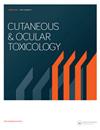白内障手术中使用肾上腺素和胰蓝对假性角膜外翻综合征患者解剖和功能结果的影响
IF 1.3
4区 医学
Q3 OPHTHALMOLOGY
引用次数: 0
摘要
目的评估白内障手术中使用的巩膜内肾上腺素和胰胆素蓝对假性角膜剥脱综合征(PEX)患者角膜内皮参数的影响。方法根据白内障手术中术中用药情况将患者分为四组:巩膜内肾上腺素(1/10000,0.结果各组间术前ECD、CV、HEX和CCT参数相似。与术前相比,术后三个月的 ECD 平均下降了 12.7%。在第 3 组中,发现术后第三个月的 ECD 比术前低(p = 0.014)。结论:总之,巩膜内肾上腺素或胰岛素蓝的使用并未导致 PEX 患者角膜内皮的显著差异。不过,这两种药物的联合使用可能会对内皮细胞密度产生负面影响。在存在 PEX 的情况下进行白内障手术时,应考虑到内皮损伤的可能性增加,并在术前和术中采取适当的预防措施。本文章由计算机程序翻译,如有差异,请以英文原文为准。
The Effect of Adrenaline and Trypan Blue Used During Cataract Surgery on Anatomical and Functional Outcomes in Pseudoexfoliation Syndrome Patients.
PURPOSE
To evaluate the effect of the intracameral adrenaline and trypan blue used during cataract surgery on corneal endothelial parameters in pseudoexfoliation syndrome (PEX) patients.
METHODS
The patients were divided into four groups according to intraoperative use of agents during cataract surgery: intracameral adrenaline (1/10,000, 0.1 ml) (group 1), trypan blue (0.6 mg/ml, 0.1 ml) (group 2), combination of adrenaline and trypan blue (group 3) and none (group 4).
RESULTS
Preoperative ECD, CV, HEX and CCT parameters were similar between the groups. A mean loss of 12.7% in ECD was observed at the postoperative third months compared to the preoperative. In group 3, ECD was found to be lower in the postoperative third months compared to the preoperative (p = 0.014). In the other groups, no statistically significant difference was found in preoperative and postoperative comparisons.
CONCLUSION
In conclusion, the utilization of intracameral adrenaline or trypan blue did not cause a significant difference in corneal endothelium in PEX patients. However, their combined use may have a negative effect on endothelial cell density. In a cataract surgery performed in the presence of PEX, the increased likelihood of endothelial damage should be taken into consideration, and appropriate precautions should be taken preoperatively and intraoperatively.
求助全文
通过发布文献求助,成功后即可免费获取论文全文。
去求助
来源期刊
CiteScore
3.30
自引率
6.20%
发文量
40
审稿时长
1 months
期刊介绍:
Cutaneous and Ocular Toxicology is an international, peer-reviewed journal that covers all types of harm to cutaneous and ocular systems. Areas of particular interest include pharmaceutical and medical products; consumer, personal care, and household products; and issues in environmental and occupational exposures.
In addition to original research papers, reviews and short communications are invited, as well as concise, relevant, and critical reviews of topics of contemporary significance.

 求助内容:
求助内容: 应助结果提醒方式:
应助结果提醒方式:


